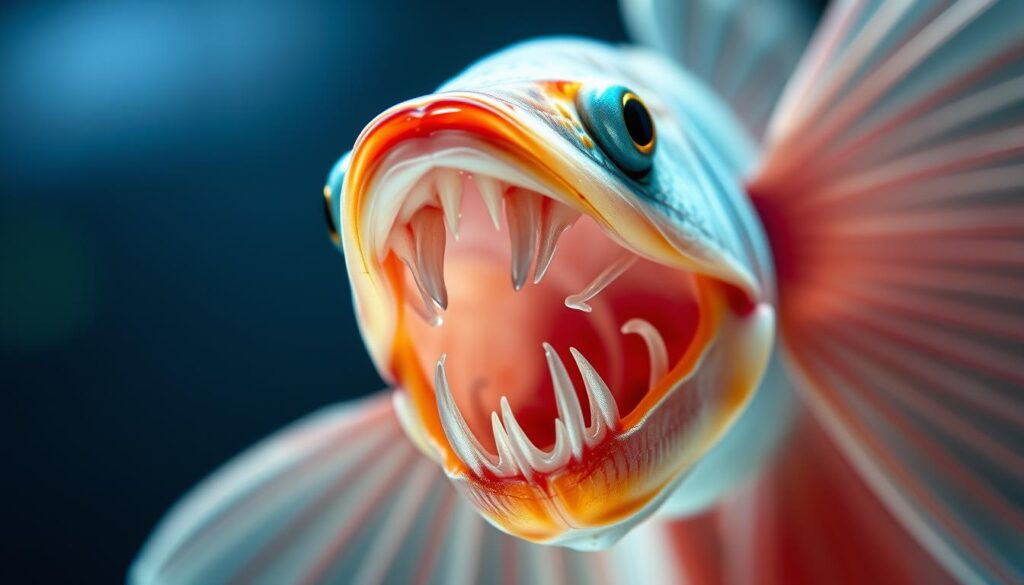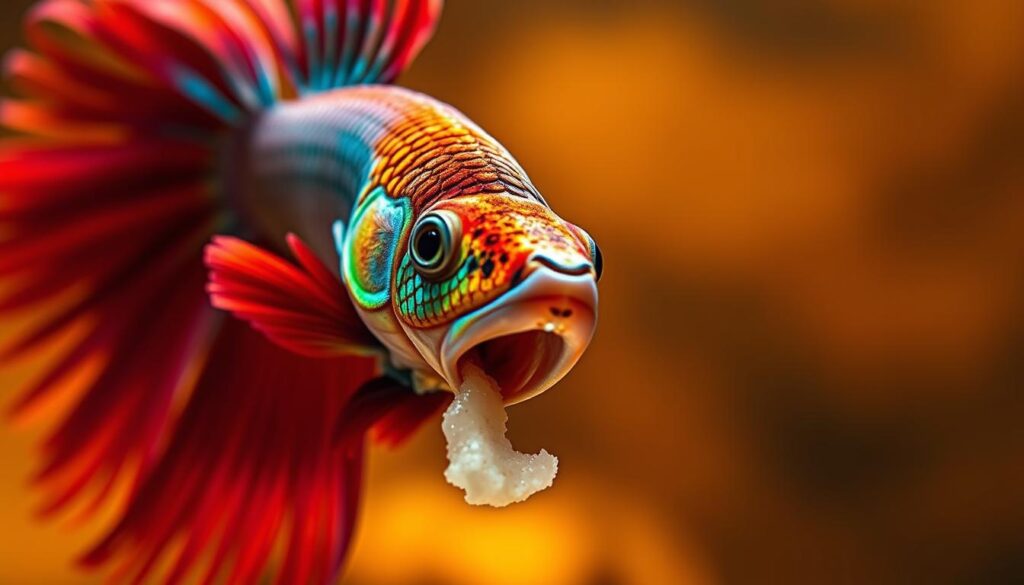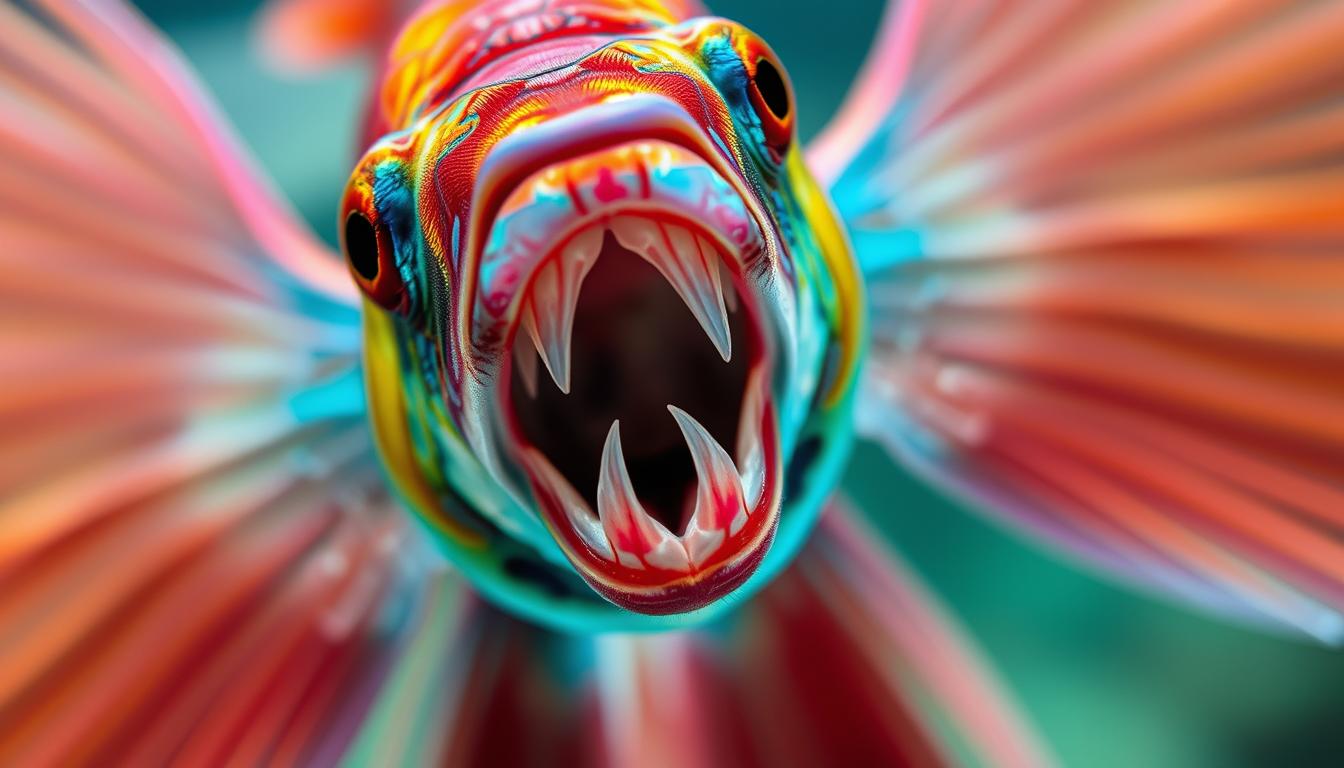Do betta fish have teeth? If you’ve ever watched your colorful little fighter dart around the tank, flaring its fins and acting like a mini dragon, you’ve probably wondered — can it actually bite? Surprisingly, the answer is yes! Betta fish do have teeth — tiny, sharp ones — and they’re not just for show. In this article, we’ll uncover everything you need to know about those secret little chompers, from how they eat to whether or not you should be worried about a nibble on your finger. Let’s dive in!
It’s a question that might seem simple, but the answer is quite fascinating! Betta fish are indeed equipped with teeth, but that’s just the beginning. As we dive into the world of betta fish, we’ll explore some surprising facts that might just change the way you care for these beautiful creatures.
Key Takeaways
- Betta fish are equipped with teeth, which are often overlooked.
- Their dental structure is adapted to their feeding habits.
- Understanding betta fish anatomy can improve their care.
- Betta fish have unique characteristics that set them apart.
- Learning about betta fish can enhance your aquarium experience.
The Fascinating World of Betta Fish
In the realm of aquarium pets, few creatures are as captivating as the betta fish. With their elaborate fins and vibrant colors, it’s no wonder they’ve become a favorite among aquarium enthusiasts. Their unique appearance is just the beginning of what makes them so fascinating!
Origin and Natural Habitat of Siamese Fighting Fish
Betta fish, also known as Siamese fighting fish, originate from the warm, freshwater areas of Southeast Asia. They thrive in shallow waters, such as rice paddies, slow-moving streams, and marshes. In their natural habitat, betta fish have adapted to survive in environments with low oxygen levels, developing a unique labyrinth organ that allows them to breathe air from the surface.
Why Bettas Have Become Popular Aquarium Pets
Betta fish have become incredibly popular pets due to their relatively low maintenance care and stunning appearance. Their ability to thrive in small spaces, coupled with their elaborate fins and vibrant colors, makes them an ideal choice for many aquarium enthusiasts. Moreover, understanding aspects of their betta fish dental structure and betta fish oral health can help owners provide better care for these captivating creatures.
By appreciating the origins and unique characteristics of betta fish, owners can gain a deeper understanding of these fascinating pets. Whether you’re a seasoned aquarium enthusiast or a newcomer to the world of betta fish, there’s always more to learn about these captivating creatures and how to ensure their optimal health, including their dental well-being.
Do Betta Fish Have Teeth? The Surprising Answer
Let’s dive into the fascinating world of betta fish anatomy and answer the burning question: do betta fish have teeth? You might be surprised to learn that betta fish do indeed have teeth, but they’re quite different from what you might expect!
The Truth About Betta Fish Dentition
Betta fish have a unique dental structure that’s adapted to their specific feeding habits. Their teeth are very small, often referred to as “dental villi,” and are used for grasping and holding onto food rather than chewing it. This specialized dentition allows betta fish to eat a variety of foods, from commercial flakes to live or frozen brine shrimp. In fact, betta fish have a pair of dental plates in their mouth, which are lined with these tiny teeth.

It’s worth noting that betta fish teeth are not designed for tearing or piercing flesh like some other predatory fish. Instead, they’re more suited for catching and eating small invertebrates and commercial fish foods.
Common Misconceptions About Betta Teeth
One common misconception about betta fish is that they don’t have teeth because they’re not visible to the naked eye. This couldn’t be further from the truth! While it’s true that betta teeth are tiny and not easily seen, they are indeed present and play a crucial role in the fish’s feeding behavior.
Another myth is that betta fish are aggressive biters, but this is largely exaggerated. While betta fish can and will bite if threatened or during courtship, their teeth are not designed for attacking humans or other large animals.
Read Also Gas Bubble Disease in Betta Fish: Causes, Symptoms & Treatment Guide
Anatomy of Betta Fish Teeth
Let’s dive into the fascinating world of betta fish teeth and explore their unique anatomy! Betta fish, known for their elaborate fins and vibrant colors, also have some intriguing dental features. Their teeth are tiny, sharp, and play a crucial role in their feeding and defense mechanisms.

Size and Structure of Betta Dental Features
Betta fish teeth are remarkably small, which can make them difficult to observe with the naked eye. Despite their size, these teeth are sharp and pointed, designed for catching and eating prey. The structure of betta fish teeth is adapted to their diet and environment, showcasing the evolutionary adaptations of these fascinating creatures.
The teeth are made of a hard, calcified material that allows them to effectively grasp and process food. This dental structure is crucial for betta fish survival, enabling them to eat a variety of foods including small insects, plankton, and even smaller fish in the wild.
Location and Arrangement in the Mouth
The location and arrangement of betta fish teeth within their mouth are quite unique. Their teeth are situated in the jaws, with the front teeth being more prominent. The arrangement allows for efficient capture and processing of food, making betta fish effective predators in their natural habitat.
Understanding the betta fish mouth structure and how their teeth are arranged can provide insights into their feeding behavior and overall health. By knowing more about their dental anatomy, betta owners can better care for their pets, ensuring they receive the appropriate nutrition and maintain good oral health.
The Function of Teeth in Betta Fish
Betta fish teeth are more than just a fascinating feature; they play a crucial role in the fish’s daily life! Let’s dive into the functional aspects of these tiny teeth and explore how they contribute to the betta’s overall well-being.
Feeding Mechanics and Food Processing
Betta fish use their teeth to grasp and eat their food. Their dental structure allows them to capture and process a variety of foods, from commercial flakes to live or frozen brine shrimp. The way betta fish teeth are designed enables efficient feeding, making mealtime a successful experience for these beautiful creatures!
Here are some key points about how betta fish use their teeth for feeding:
- They use their teeth to grip food particles, preventing them from escaping.
- The structure of their teeth allows for the processing of different food types.
- Efficient feeding mechanics contribute to the overall health of the betta fish.

Role in Territorial Defense and Aggression
Betta fish are known for their territorial behavior, and their teeth play a significant role in this aspect. When betta fish feel threatened or when they’re competing for dominance, they may display aggressive behavior, which can include biting. This behavior is a natural response, showcasing the importance of their teeth in defense mechanisms.
Some interesting facts about betta fish aggression include:
- Territorial defense is a primary reason for aggression in betta fish.
- Betta fish may bite other fish or even their owners during displays of aggression.
- Understanding and managing aggression is crucial for keeping betta fish healthy and happy.
By understanding the dual role of betta fish teeth in feeding and defense, we can better appreciate these remarkable creatures and their unique adaptations!
Betta Fish Biting Behavior
The biting behavior of betta fish is a complex topic that reveals interesting insights into their nature. As we explore this aspect of betta fish behavior, you’ll discover that their biting is not just a simple reflex, but rather a response to various stimuli.

Triggers That Cause Bettas to Bite
Betta fish may bite when they feel threatened or during territorial disputes. Some common triggers include:
- Seeing their reflection in the tank walls or nearby surfaces
- Being exposed to other betta fish, especially males
- Feeling confined or stressed due to inadequate tank size or conditions
Understanding these triggers can help you manage your betta’s environment to minimize biting incidents.
Are Betta Bites Dangerous to Humans?
While betta fish can bite, their bites are generally not dangerous to humans. Their teeth are small and primarily designed for eating and territorial displays. However, it’s essential to handle betta fish gently and carefully to avoid provoking a bite.
If you do get bitten, it’s usually more of a surprise than a cause for concern. Betta bites are not venomous, and any discomfort is typically minor and temporary.
In conclusion, betta fish biting behavior, while intriguing, is largely a response to specific stimuli. By understanding and managing these triggers, you can create a harmonious environment for both you and your betta fish.
Diet and How Betta Fish Use Their Teeth
A betta fish’s diet is more than just throwing some flakes into the tank; it’s about providing the right nutrition! As carnivorous creatures, betta fish require a diet rich in protein to thrive. But how does this relate to their teeth? Let’s dive into the world of betta fish feeding habits and explore how they use their teeth.
Natural Prey and Feeding Habits in the Wild
In their natural habitat, betta fish feed on small insects, plankton, and even tiny crustaceans. They use their teeth to grab and hold onto their prey, making mealtime a bit of a wrestling match! In the wild, betta fish are opportunistic feeders, taking advantage of whatever food sources are available.
Optimal Diet for Captive Bettas
So, what does this mean for your pet betta? To keep your betta healthy and happy, you need to replicate their natural diet as closely as possible. This means providing a varied and nutrient-rich diet that includes plenty of protein.
Commercial Foods vs. Live Foods
Commercial betta pellets or flakes can be a good staple, but you can also supplement with live or frozen foods like brine shrimp or bloodworms. “Variety is the spice of life,” and this holds true for betta fish too! Mixing up their diet will keep them engaged and stimulated.
Feeding Frequency and Portion Control
Overfeeding is a common mistake betta owners make. To avoid this, feed your betta 2-3 times a day, only as much as they can consume within a minute or two. This will help prevent digestive issues and keep your betta’s teeth in top condition!
By understanding and replicating the natural diet of betta fish, you can help maintain their oral health and overall well-being. A well-fed betta is a happy betta, and with the right diet, you’ll be enjoying a thriving, healthy pet for years to come!
Oral Health Issues in Betta Fish
Oral health is a crucial aspect of betta fish care that is often overlooked by many aquarium enthusiasts! As responsible betta owners, it’s essential to understand that these beautiful creatures can suffer from various oral health issues, just like humans do.
Common Dental and Mouth Problems
Betta fish can experience a range of dental and mouth problems, including infections, dental decay, and physical damage to their mouth or teeth. These issues can arise from poor water quality, inadequate diet, or even genetic predispositions! For instance, a diet lacking essential nutrients can weaken their dental structure, making them more susceptible to decay.
Moreover, betta fish are prone to mouth injuries, especially if their environment is not carefully managed. Sharp decorations or aggressive tankmates can cause physical trauma, leading to infections or other complications.
Recognizing Signs of Oral Disease
So, how do you identify if your betta fish is suffering from oral health issues? Look out for signs such as visible swelling or redness around the mouth, labored feeding, or a decrease in appetite. Your betta might also exhibit lethargic behavior or swim irregularly if they’re experiencing oral pain!
Regularly inspecting your betta’s mouth and overall behavior can help you catch these issues early. If you suspect your betta is suffering from an oral health problem, consult with a veterinarian experienced in fish care for proper diagnosis and treatment.
Caring for Your Betta’s Dental Health
Let’s dive into the world of betta fish dental care and explore how you can keep your finned friend’s teeth in top shape! Caring for your betta’s dental health is an essential part of being a responsible pet owner. By focusing on the right nutrition and maintaining optimal water quality, you can help prevent oral health issues and keep your betta thriving.
Nourishing Your Betta for Healthy Teeth
A well-balanced diet is vital for maintaining your betta’s dental health. Feed your betta a variety of nutrient-rich foods, including high-quality commercial pellets, live or frozen foods like brine shrimp, and occasional treats like bloodworms. Avoid overfeeding, as this can lead to digestive issues and negatively impact oral health.
| Food Type | Nutritional Benefits | Feeding Frequency |
|---|---|---|
| High-quality pellets | Rich in proteins, vitamins, and minerals | Daily |
| Live or frozen brine shrimp | High in protein, promotes healthy growth | 2-3 times a week |
| Bloodworms | Rich in protein, a nutritious treat | Occasional treat |
The Impact of Water Quality on Oral Health
Maintaining optimal water quality is crucial for your betta’s overall health, including their dental well-being. Regular water changes help remove bacteria, debris, and excess nutrients that can contribute to oral health issues. Ensure your betta’s tank is properly filtered and maintained at the right temperature.
By combining a balanced diet with excellent water quality, you’ll be well on your way to keeping your betta’s teeth healthy and strong. Remember, a healthy betta is a happy betta!
Comparing Betta Teeth to Other Fish Species
When it comes to aquarium fish, betta fish have some of the most distinctive dental features – but how do they compare to other popular species? Let’s take a closer look at how betta teeth stack up against other common aquarium fish.
How Betta Teeth Differ from Other Popular Aquarium Fish
Betta fish have unique dental features that are adapted to their diet and environment. Unlike some other popular aquarium fish, betta fish have small, conical teeth that are designed for catching and eating small prey. For example, compared to goldfish, which have larger, more robust teeth for grinding food, betta fish teeth are more delicate.
In contrast to cichlids, which often have large, prominent teeth for defending territory and capturing prey, betta fish teeth are generally smaller and more specialized for their specific feeding habits.
Read Also Baby Betta Fish Diseases: Common Illnesses & How to Treat Them Early
Evolutionary Adaptations of Betta Mouth Structure
The mouth structure of betta fish has evolved to suit their specific needs. Their upturned mouth allows them to feed on the surface of the water, making them well-adapted to their natural environment. This unique adaptation is a key factor in their ability to thrive in their native habitats.
By understanding how betta teeth compare to other fish species, we can gain a deeper appreciation for these fascinating creatures and better care for their needs in our aquariums.
Interesting Facts About Betta Fish Beyond Their Teeth
Betta fish are more than just their stunning appearance and fascinating teeth – they have some truly remarkable traits that set them apart from other aquarium fish! Let’s dive into some of the most interesting aspects of betta fish biology and behavior.
Labyrinth Organ: The Unique Breathing Adaptation
Betta fish have a special organ called the labyrinth, which allows them to breathe air from the surface of the water. This adaptation is crucial for their survival in low-oxygen environments. The labyrinth organ is made up of complex, folded structures that absorb oxygen from the air, allowing betta fish to thrive in conditions that would be challenging for other fish.
Intelligence and Owner Recognition Abilities
Betta fish are often underestimated when it comes to their intelligence, but they are capable of recognizing their owners and responding to their presence. They can even be trained to perform simple tricks! This intelligence, combined with their curious nature, makes betta fish a joy to interact with.
Courtship and Breeding Behaviors
Betta fish have a complex courtship ritual that involves a series of displays and interactions between the male and female. The male betta builds a bubble nest to shelter the eggs and protect them from predators. After spawning, the male guards the nest and cares for the eggs until they hatch. This fascinating behavior is a testament to the intricate social dynamics of betta fish.
| Behavior | Description |
|---|---|
| Labyrinth Breathing | Allows betta fish to survive in low-oxygen environments |
| Owner Recognition | Betta fish can recognize and respond to their owners |
| Courtship Rituals | Complex displays and interactions between male and female betta fish |
Conclusion: Understanding Your Betta’s Unique Anatomy
Now that we’ve explored the fascinating world of betta fish and dived into the details of their teeth, it’s clear that understanding betta fish anatomy is crucial for providing the best care. Betta fish teeth may be small, but they play a significant role in their feeding mechanics and territorial defense!
By grasping the intricacies of betta fish anatomy, you can better appreciate these amazing creatures and ensure they’re living their best lives. Whether you’re a seasoned betta owner or just starting out, knowing the ins and outs of betta fish care can make all the difference in creating a happy and healthy environment for your finned friend.
So, as you continue to learn and grow with your betta, remember that their unique anatomy is what makes them so captivating. Keep exploring, keep learning, and most importantly, enjoy the journey with your betta fish!

